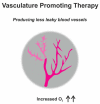Inducing Angiogenesis, a Key Step in Cancer Vascularization, and Treatment Approaches
- PMID: 32384792
- PMCID: PMC7281705
- DOI: 10.3390/cancers12051172
Inducing Angiogenesis, a Key Step in Cancer Vascularization, and Treatment Approaches
Abstract
Angiogenesis is a term that describes the formation of new blood and lymphatic vessels from a pre-existing vasculature. This allows tumour cells to acquire sustenance in the form of nutrients and oxygen and the ability to evacuate metabolic waste. As one of the hallmarks of cancer, angiogenesis has been studied extensively in animal and human models to enable better understanding of cancer biology and the development of new anti-cancer treatments. Angiogenesis plays a crucial role in the process of tumour genesis, because solid tumour need a blood supply if they are to grow beyond a few millimeters in size. On the other hand, there is growing evidence that some solid tumour exploit existing normal blood supply and do not require a new vessel formation to grow and to undergo metastasis. This review of the literature will present the current understanding of this intricate process and the latest advances in the use of angiogenesis-targeting therapies in the fight against cancer.
Keywords: VEGF; angiogenesis; anticancer; cancer.
Conflict of interest statement
The authors declare no conflict of interest.
Figures






Similar articles
-
Growing tumor vessels: more than one way to skin a cat - implications for angiogenesis targeted cancer therapies.Mol Aspects Med. 2011 Apr;32(2):71-87. doi: 10.1016/j.mam.2011.04.001. Epub 2011 Apr 22. Mol Aspects Med. 2011. PMID: 21540050 Review.
-
Are tumours angiogenesis-dependent?J Pathol. 2004 Jan;202(1):5-13. doi: 10.1002/path.1473. J Pathol. 2004. PMID: 14694516 Review.
-
Vascular Endothelial Growth Factor (VEGF) Signaling in Tumour Vascularization: Potential and Challenges.Curr Vasc Pharmacol. 2017;15(4):339-351. doi: 10.2174/1570161115666170105124038. Curr Vasc Pharmacol. 2017. PMID: 28056756 Review.
-
Vessel co-option in cancer.Nat Rev Clin Oncol. 2019 Aug;16(8):469-493. doi: 10.1038/s41571-019-0181-9. Nat Rev Clin Oncol. 2019. PMID: 30816337 Review.
-
Tumour-Endothelial Cell Communications: Important and Indispensable Mediators of Tumour Angiogenesis.Anticancer Res. 2016 Mar;36(3):1119-26. Anticancer Res. 2016. PMID: 26977007 Review.
Cited by
-
Antiangiogenic Activity of n-hexane Insoluble Fraction and Its Tylophorine Component from Ficus septica Leaves in Chicken Chorioallantoic Membrane Induced by bFGF.Asian Pac J Cancer Prev. 2023 Jan 1;24(1):75-80. doi: 10.31557/APJCP.2023.24.1.75. Asian Pac J Cancer Prev. 2023. PMID: 36708554 Free PMC article.
-
More Than Meets the Eye Regarding Cancer Metabolism.Int J Mol Sci. 2021 Sep 1;22(17):9507. doi: 10.3390/ijms22179507. Int J Mol Sci. 2021. PMID: 34502416 Free PMC article. Review.
-
The 14-Kilodalton Human Growth Hormone Fragment a Potent Inhibitor of Angiogenesis and Tumor Metastasis.Int J Mol Sci. 2023 May 17;24(10):8877. doi: 10.3390/ijms24108877. Int J Mol Sci. 2023. PMID: 37240223 Free PMC article.
-
Potential Antitumor Effect of α-Mangostin against Rat Mammary Gland Tumors Induced by LA7 Cells.Int J Mol Sci. 2023 Jun 17;24(12):10283. doi: 10.3390/ijms241210283. Int J Mol Sci. 2023. PMID: 37373429 Free PMC article.
-
Anti-metastatic Potential of Natural Triterpenoid Cucurbitacin B Against Cholangiocarcinoma Cells by Targeting Src Protein.Integr Cancer Ther. 2022 Jan-Dec;21:15347354221124861. doi: 10.1177/15347354221124861. Integr Cancer Ther. 2022. PMID: 36154723 Free PMC article.
References
-
- Suh D.Y. Understanding angiogenesis and its clinical applications. Ann. Clin. Lab. Sci. 2000;30:227–238. - PubMed
Publication types
LinkOut - more resources
Full Text Sources
Research Materials

